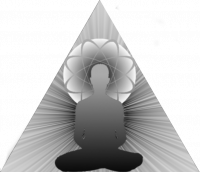
Scio-Buddhism
Faith and Philosophy Consistent with Reason and Reality
| Previous Page | Table of Contents | Next Page | 1:3 Ontology Versus PracticeSiddhartha Gautama left no writings of his own; in fact, writing itself was not even known in the time and place of his life. The historical record of his teachings therefore comes by way of others who preserved his teachings – first through oral tradition, and later through writing. Just as the vast majority of people are mystical in modern times, so too were they mystical in such ancient times, although even much more so. Thus the words of the Buddha come not only by way of others, but by way of others who were almost universally mystics. It therefore quite unsurprising that the version of Buddhist ontology (those things or classes of things which are considered to exist or to be possible to exist) which has been passed down to later ages contained certain things which Scionics (and most accepted science) now correctly identifies as ontologically invalid – in other words, mystical, supernatural, and so on. In contrast to this somewhat invalid ontology, however, the vast majority of the practices taught by the Buddha, most particularly his mental practices, were highly effective and remain valid to this day. This is because these valid practices are not founded or dependent upon the invalid aspects Buddhist ontology, but instead are the result of experimentation and experience, and are verified or validated by the fact that they work, and work very well. It should be noted that it would be essentially unthinkable for the practices of other traditional world religions to meaningfully stand on their own, in the absence of their respective associated ontologies. The act of prayer, so common and central to so many traditional religions (as just one example) only makes sense if one accepts the ontological validity of supernatural beings capable of and willing to respond to such prayers. The meditative practices of Buddhism, on the other hand, require the existence and assistance of no supernatural beings whatsoever to achieve their desired effects. One cannot say with certitude whether any particular ontological mysticism in Buddhism originated with the Buddha himself, or was instead the result of subsequent inaccurate transmission of his teachings. What can be said however, from an examination of the earliest written Buddhist texts – presumably the most reflective of the actual, original teachings of the Buddha – is that the absolutely central and essential Buddhist concepts (which will be identified and examined later in this writing) are simply devoid of all mysticism. Surrounding these non-mystical concepts, however, were a number of plainly mystical concepts. Thus early Buddhist concepts may be divided into two distinct classes: the non-mystical central concepts, and the peripheral mystical concepts. This is not done out of a sense of dishonesty or malice on the part of parents. Parents typically love their children dearly, and also have far more understanding about both the world and their children than the children can possibly realize. While it is generally a good policy to be as honest with little children as possible, there are just certain situations where a “white lie” is actually the most wise and loving course of action. This seems to be essentially the function performed by the peripheral concepts found in early Buddhism. The central, non-mystical practices are immeasurably beneficial, providing a true path to such things as profound inner peace and equanimity, among others great benefits. They also tend to minimize a type of thinking which might be called “mystical speculation” as essentially irrelevant to the path of Buddhism. The peripheral and mystical ontological concepts, on the other hand, never seems to be of the type which would tend to promote self-destructive activities or the exploitation of others. Instead they seem to serve a similar purpose to the wise and loving “white lies” parents sometime tell their very young children: to gently encourage positive behaviors and thoughts in general, and in this particular case to reinforce adherence to the central, non-mystical and enormously beneficial practices of Buddhism. While the core practices of early Buddhism are free of mysticism, it does certainly remain possible that the Buddha himself was a mystic, and “accidentally” formulated a core set of non-mystical concepts and practices, while the mystical aspects of his teaching just happened to be largely benign, non-essential peripheral ontologies which reinforced adherence to the non-mystical core; this is highly unlikely, of course. In any event, the important thing for the purposes of this writing is not whether or to what degree the Buddha was mystical, but the examination of these core concepts and the enormous benefits they deliver: their non-mystical nature and enormous benefits are their own justification. The replacement of mystical ontologies by the reality-based, non-mystical ontology of Scionics serves to even further increase the efficacy of the path towards higher consciousness and ultimate liberation from suffering. | Previous Page | Table of Contents | Next Page | |
Please help advance Scio-Buddhism by commenting:
We welcome all comments, positive and negative, about our work and our website. We are particularly interested in any errors you find, whether these be simple typographical errors, or errors in facts or logic. If reporting an error, please be as specific as possible in identifying it, so that we will be able to properly identify and assess it. You may leave a publicly visible comment below, or in our forums, or you may send us a private comment using our contact page.
© 1988-2025 The Scionics Institute
© 2012-2025 The Church of Scio-Buddhism